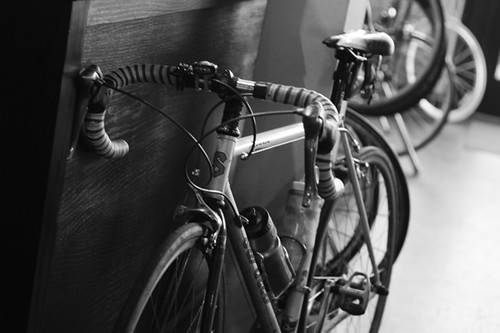I've mentioned before that I've been shopping around for a road/racing bike since last May, and that I hoped to write about the process once I bought one. With Spring just around the corner, I am getting emails from readers who are going through the same ordeal and feeling lost, wondering whether I plan to post a guide of some sort. The quick answer is "no." I am sorry to disappoint, but I can offer no helpful advice on this topic at the moment.
Many roadbike shopping stories I hear or receive from readers are very similar to my own experience. It starts with a decision to buy a roadbike. Nothing unusual - a fast modern roadbike for paceline rides, group rides, and so on. So at first you're thinking "Well, since I don't necessarily want anything 'lovely,' this should be easy. There are bike shops filled with roadbikes and nothing but roadbikes after all." And optimistically you head to these bike shops... only to discover that there really aren't as many options as you thought.
Most guides to buying a new roadbike will tell you that fit is the main thing, and that once you have that down everything else will fall into place. Okay. So I've been fitted by several different professionals now, with the consensus that I have fairly standard proportions for a woman of my height and that I require a road frame that is 52cm x 53cm or thereabouts. It is not difficult to find a stock roadbike with these dimensions, so in theory I should be all set. In practice however, there is much more to it.
For one thing, there is the dreaded toe overlap. I do not want to spark a debate on this topic yet again, so let's just say that some cyclists dislike TCO and leave it at that. I happen to be one of those cyclists, and it is not easy to find a stock frame in a small size that does not have this issue. So even though the right frame size is easy enough to find, the right frame size with no TCO limits the pool of available bikes considerably.
But a much larger issue that tends to be glossed over in bike shops, is that roadbikes don't all handle the same and don't all have the same ride quality. These factors are important to me. I would be miserable on a bike with a harsh ride or on a bike that I cannot control on turns. Realistically, I need to test-ride a roadbike for at least 20 miles on hilly terrain in order to determine whether I am comfortable with it - essentially, I need to simulate the sort of ride I would normally be doing on the bike. And that is usually not possible.
Apparently many bike shops expect you to test ride a bicycle either in their parking lot or around the block. At most they expect a test ride to be a couple of miles. Taking a bike on an actual 20 mile ride? In my experience, only a handful of shops will allow this, and those shops tend to be high-end with expensive bikes.
An additional problem for me personally, is that I cannot use Shimano STI levers - what the vast majority of demo roadbikes in the vast majority of bike shops are fitted with. There is something about the shape of Shimano STIs that my hands don't like, and I cannot safely brake on a bike with these levers. This limits me severely on the bikes I am able to test ride, even if I am allowed to take them on a long ride.
The problem of testing before buying is also what made me wary of going custom. Framebuilders are wonderful, but no matter how much you communicate there is no guarantee that the bike they make will feel and handle as you want it to. Very few framebuilders offer demo bikes, and most of us are not lucky enough to have acquaintances whose custom bikes we can try. A blind purchase of a custom roadframe seems risky to me - especially if you are relying on it for a particular date/event and do not already have a roadbike to fall back on if something goes wrong (or takes longer than expected).
Going semi-custom, building up a stock frame from scratch, or refurbishing a vintage frame with new components, similarly involve risking the unknown, albeit at a lesser cost.
Going semi-custom, building up a stock frame from scratch, or refurbishing a vintage frame with new components, similarly involve risking the unknown, albeit at a lesser cost.
So what solution am I proposing? Well that is just the thing, I am not. Ultimately everyone will need to find their own solution and for many that will involve trial and error. Not everyone is sensitive to a bike's ride quality and handling. Not everyone cares about things like toe overlap. Individual preferences and skill levels play into it a great deal. As does simple luck. Some get lucky and buy a roadbike they are comfortable with on their first try. And reading this, they will no doubt think I am overcomplicating things. But others will face one frustration after another, and may even give up roadcycling as a result of not finding a bike they are comfortable with. If you find yourself in that category, I can only encourage you to be patient and not give up. Try to identify the problems you are having with your current bike or with the bikes you are trying in stores. It may, after all, be something as simple as trying a different brand of levers you never realised existed.






0 comments:
Post a Comment